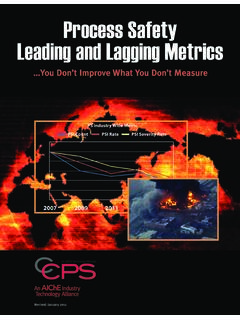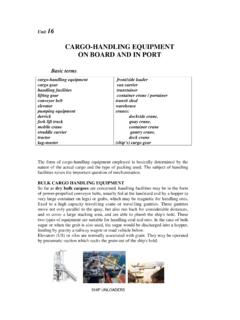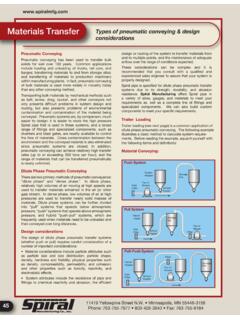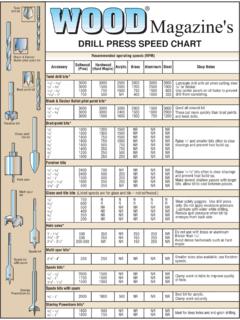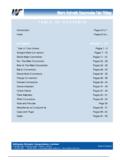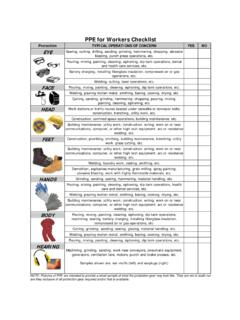Transcription of Dust Explosion Hazard Overview - AIChE
1 Dust Explosion Hazard Overview Established in 1949 Specialty chemicals Customer focused Family enterprise Today, Michelman is: Global Over 400 employees Family owned Professionally managed About Us Michelman Headquarters Cincinnati, OH Agenda Background Dust Hazard Risk factors Control Measures Background Chemical Safety Board (CSB) investigation examined 281 dust explosions Plastic dust accounted for 14% of dust explosions Common Sources of Dust Explosions per CSB Background cont. West Pharmaceutical: Polyethylene 6 Fatalities CTA Acoustics: Phenolic resin 7 Fatalities Jahn Foundry: Resins 3 Fatalities Lack of Awareness/Information Qualitative statements in SDS are less than adequate Quantitative combustible dust fire and Explosion properties are not required by OSHA Hazard /GHS 41% of the 140 combustible powder SDSs the CSB surveyed did not warn users about dust Explosion hazards What s the Hazard ?
2 Most solid organic materials will burn or explode if finely divided and dispersed (<420 microns) More than 1/32 of dust over 5% of a room s surface area is a significant Explosion Hazard Factors affecting explosivity: particle size, shape, surface area/volume ratio, humidity, etc. Dust Risk Factors MIT: Minimum Ignition Temperature Particle Distribution: Smaller means higher risk Kst Value ( ): Max. rate of pressure rise MIE: Minimum Ignition Energy (mJ) : Minimum energy that can ignite a material in air Kst How big is the boom? Dust Explosion Class Deflagration Index, Kst Range ( ) Hazard Descriptor 0 0 No Explosion 1 1 200 Weak to Moderate Explosion 2 201 300 Strong Explosion 3 >300 Very Strong Explosion Recommended Controls (MIE) MIE Guidance >100 Conductive items should be bonded and grounded.
3 Restrict use of insulating liners and coatings. 25 - 100 Ground personnel 4 - 25 Control electrostatic ignition discharge hazards from bulk granular materials of high resistivity. Consider ignition from dust clouds. 1 - 4 High sensitivity to ignition. Take the above precautions and restrict use of insulating materials. <1 Extremely sensitive to ignition. Precautions same as for flammable vapors and gases. (Source: Chilworth) *Static discharge approximately 60mJ Ignition Sources Hot surfaces Mechanical sparks/friction Electrical motors/contacts Static electricity Equipment Personnel Pouring/ pneumatic conveyance of powders/pellets What s Has the Highest Explosion Index (Kst)?
4 Charcoal Micronized Wax Flour Sugar 3 Micronized Wax 1 - Charcoal 1 - Flour 1 - Sugar What is the Easiest to Ignite in Air? Acetone Charcoal Flour grain Micronized wax Powder Micronized wax powder- <1 mJ Acetone mJ Charcoal 20 mJ Flour 25 80 mJ grain 30 mJ Misconceptions There is no risk Operating temperature is below MIT Mixing with water HMIS = 1 Sales person said it was safe Pellet, prill, or flake* Dust cloud is not visible We have used it for years! *Prill/Pellet significantly reduces risk over powder, but fines remain a Hazard and pneumatic conveyance generates static electricity Dust Control Well-designed and well-maintained Local Exhaust Ventilation (LEV) systems can capture dusts effectively to prevent unnecessary dispersion of combustible dusts where people work.
5 For loading, unloading or conveyance of materials, LEV systems can be implemented at suitable locations, taking care to not have an extensive duct network, which can cause burning materials to spread following an Explosion within the LEV system. Implement suitable housekeeping and maintenance programmes for dust collection system and filters. Vacuuming or wet cleaning methods are preferred over sweeping methods, as sweeping would tend to cause more dispersion of dust particles. Ignition Control Use suitable flame-proof equipment or non-sparking tools in areas handling combustible powders. Effective bonding and grounding of powder handling units prevents the accumulation of electrostatic charges, which can be a source of ignition when inadvertently discharged.
6 Regular continuity testing should be facilitated to ensure the effectiveness of bonding and grounding. Inert atmospheres within powder handling units eliminates the possibility of an ignition. For example, nitrogen can be used to reduce/eliminate the presence of oxygen in the atmosphere of the containment. Oxygen analysers can be employed to ensure the effectiveness of the inert gas blanketing. Explosion Relief and Venting Provide Explosion relief vents of suitable size at the right locations for powder handling units to safely vent the energy in the event of a dust Explosion . To protect persons at work, Explosion relief vents must be located or positioned away from work areas, walkways, etc.
7 Install detectors for sparks or glowing materials within equipment such as grinders, LEV ducting, etc. Adding an interlock helps to extinguish potential ignition sources or stop further conveyance of sparks or glowing materials before they reach other parts of the workplace. Separate areas handling combustible dusts from other parts of the workplace with distance. Isolating units with barriers ( chokes, baffles and isolation valves) is also a safety option. Questions?


